FIAT 500X 2014 2.G Owners Manual
Manufacturer: FIAT, Model Year: 2014, Model line: 500X, Model: FIAT 500X 2014 2.GPages: 476, PDF Size: 5.32 MB
Page 191 of 476
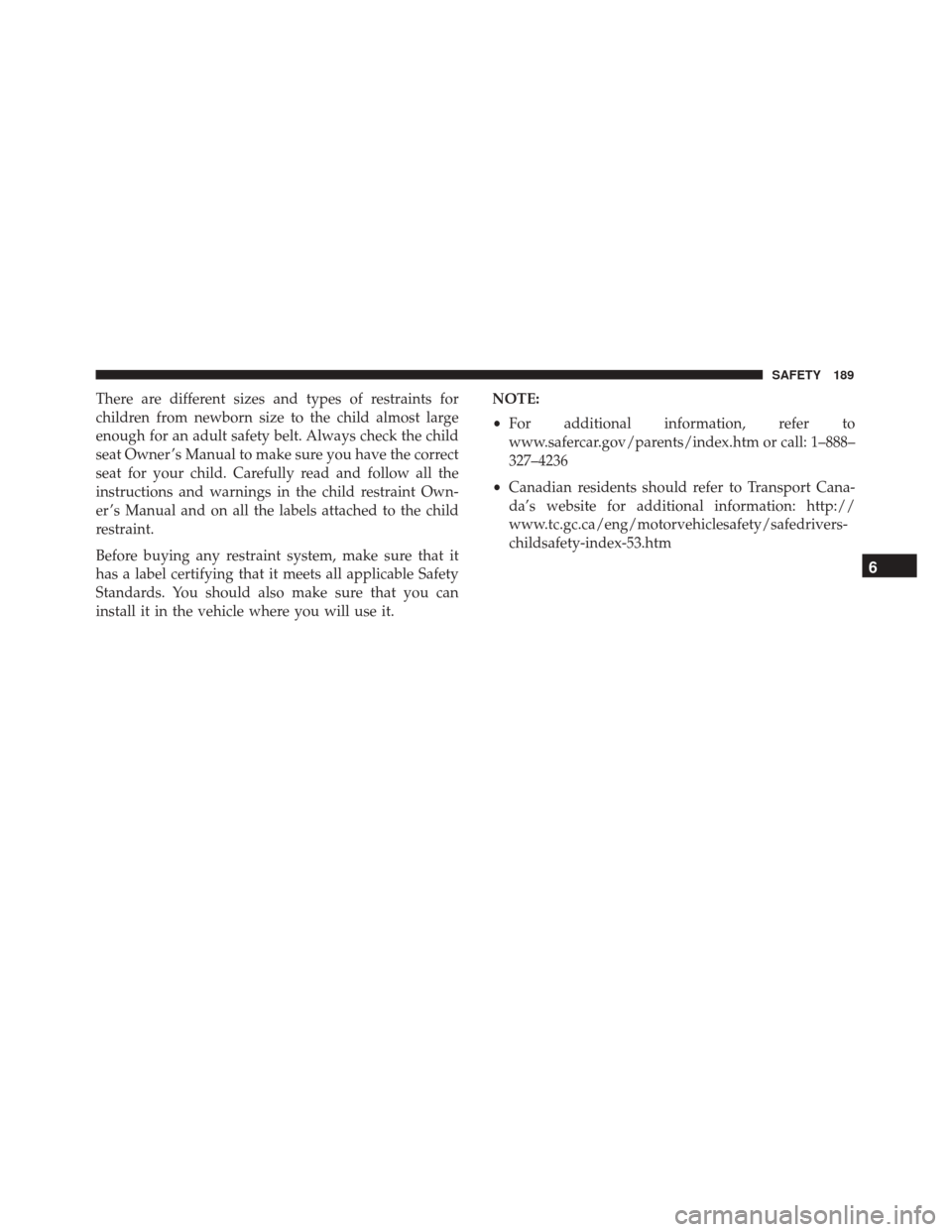
There are different sizes and types of restraints for
children from newborn size to the child almost large
enough for an adult safety belt. Always check the child
seat Owner ’s Manual to make sure you have the correct
seat for your child. Carefully read and follow all the
instructions and warnings in the child restraint Own-
er ’s Manual and on all the labels attached to the child
restraint.
Before buying any restraint system, make sure that it
has a label certifying that it meets all applicable Safety
Standards. You should also make sure that you can
install it in the vehicle where you will use it.NOTE:
•
For additional information, refer to
www.safercar.gov/parents/index.htm or call: 1–888–
327–4236
• Canadian residents should refer to Transport Cana-
da’s website for additional information: http://
www.tc.gc.ca/eng/motorvehiclesafety/safedrivers-
childsafety-index-53.htm
6
SAFETY 189
Page 192 of 476
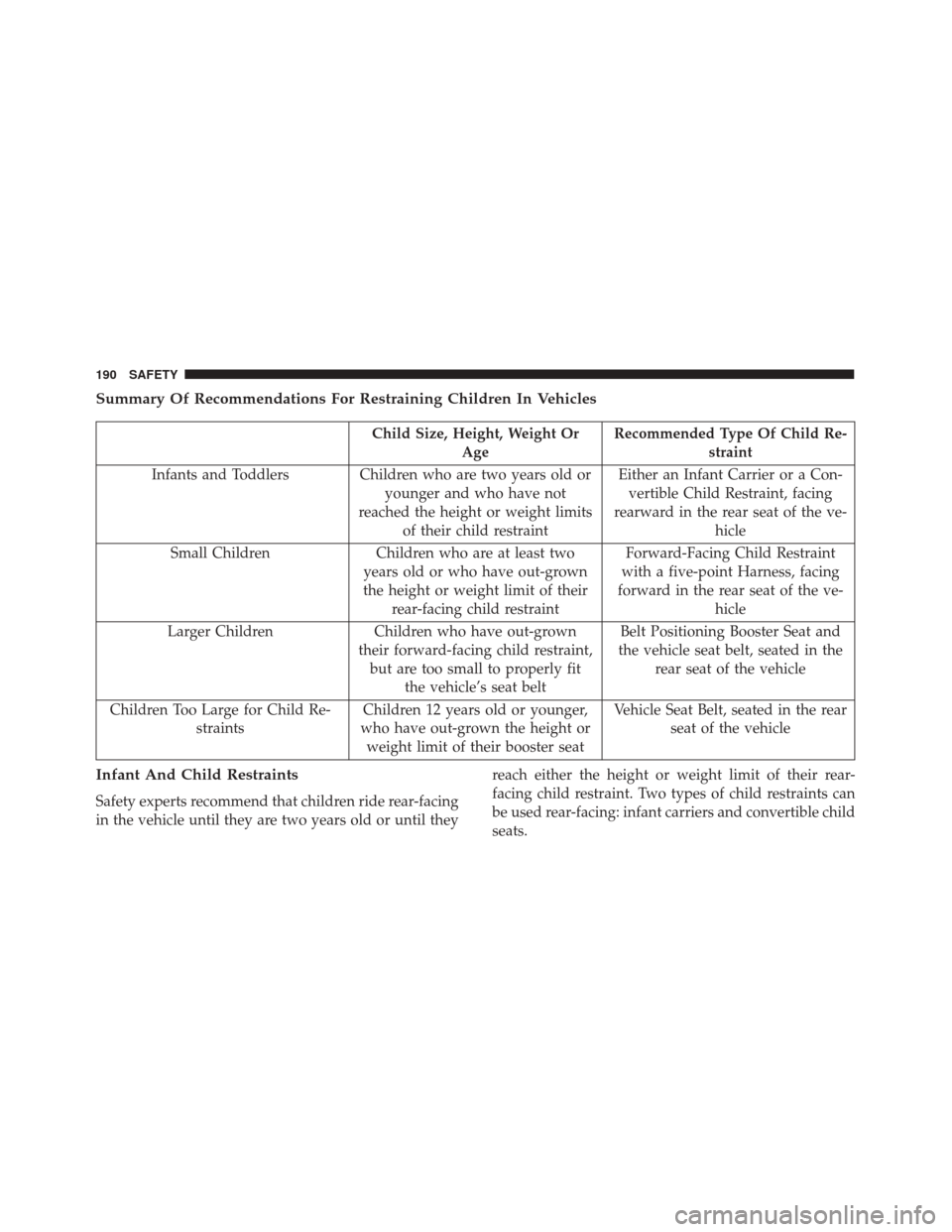
Summary Of Recommendations For Restraining Children In Vehicles
Child Size, Height, Weight OrAge Recommended Type Of Child Re-
straint
Infants and Toddlers Children who are two years old or younger and who have not
reached the height or weight limits of their child restraint Either an Infant Carrier or a Con-
vertible Child Restraint, facing
rearward in the rear seat of the ve- hicle
Small Children Children who are at least two years old or who have out-grown
the height or weight limit of their rear-facing child restraint Forward-Facing Child Restraint
with a five-point Harness, facing
forward in the rear seat of the ve- hicle
Larger Children Children who have out-grown
their forward-facing child restraint, but are too small to properly fit the vehicle’s seat belt Belt Positioning Booster Seat and
the vehicle seat belt, seated in the rear seat of the vehicle
Children Too Large for Child Re- straints Children 12 years old or younger,
who have out-grown the height or weight limit of their booster seat Vehicle Seat Belt, seated in the rear
seat of the vehicle
Infant And Child Restraints
Safety experts recommend that children ride rear-facing
in the vehicle until they are two years old or until they reach either the height or weight limit of their rear-
facing child restraint. Two types of child restraints can
be used rear-facing: infant carriers and convertible child
seats.
190 SAFETY
Page 193 of 476
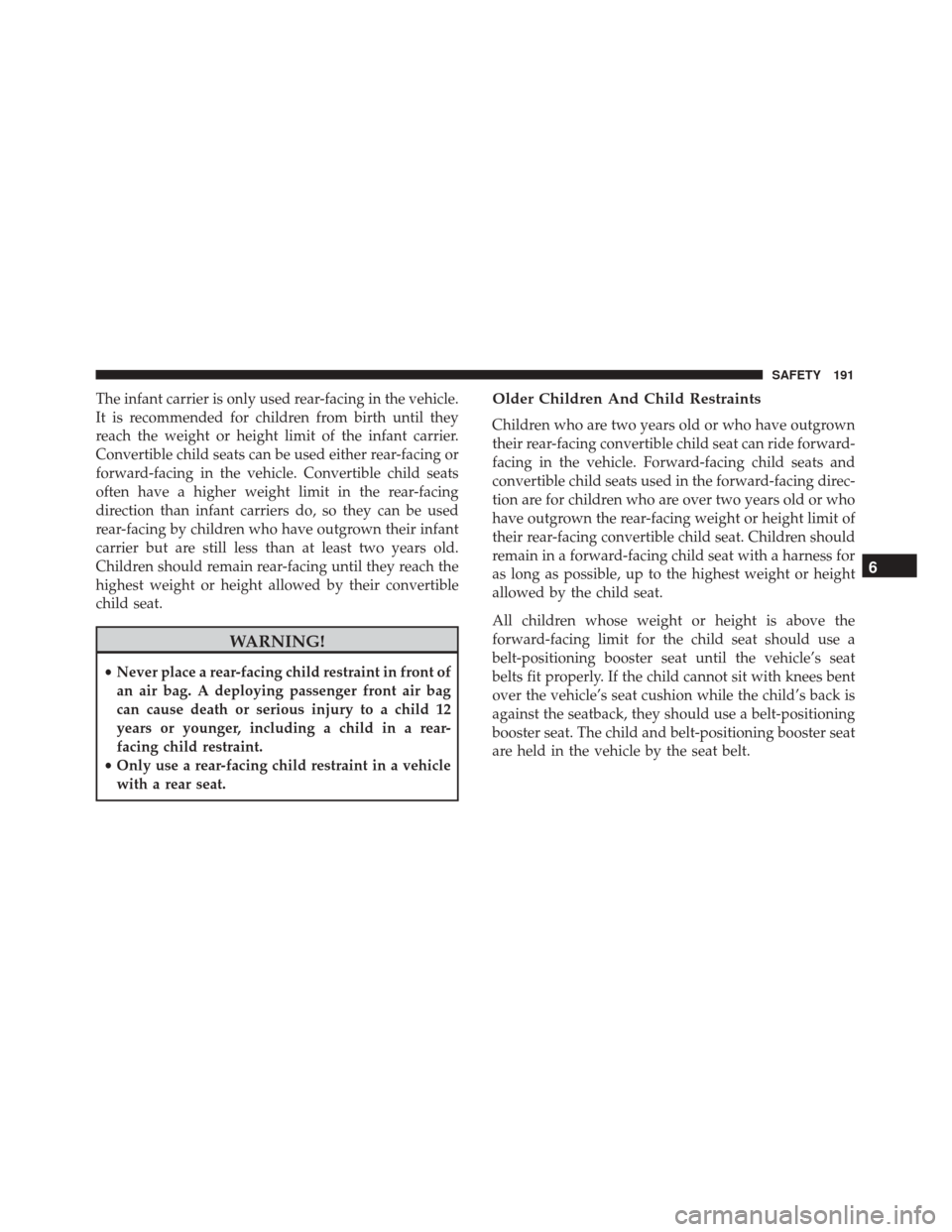
The infant carrier is only used rear-facing in the vehicle.
It is recommended for children from birth until they
reach the weight or height limit of the infant carrier.
Convertible child seats can be used either rear-facing or
forward-facing in the vehicle. Convertible child seats
often have a higher weight limit in the rear-facing
direction than infant carriers do, so they can be used
rear-facing by children who have outgrown their infant
carrier but are still less than at least two years old.
Children should remain rear-facing until they reach the
highest weight or height allowed by their convertible
child seat.
WARNING!
•Never place a rear-facing child restraint in front of
an air bag. A deploying passenger front air bag
can cause death or serious injury to a child 12
years or younger, including a child in a rear-
facing child restraint.
• Only use a rear-facing child restraint in a vehicle
with a rear seat.
Older Children And Child Restraints
Children who are two years old or who have outgrown
their rear-facing convertible child seat can ride forward-
facing in the vehicle. Forward-facing child seats and
convertible child seats used in the forward-facing direc-
tion are for children who are over two years old or who
have outgrown the rear-facing weight or height limit of
their rear-facing convertible child seat. Children should
remain in a forward-facing child seat with a harness for
as long as possible, up to the highest weight or height
allowed by the child seat.
All children whose weight or height is above the
forward-facing limit for the child seat should use a
belt-positioning booster seat until the vehicle’s seat
belts fit properly. If the child cannot sit with knees bent
over the vehicle’s seat cushion while the child’s back is
against the seatback, they should use a belt-positioning
booster seat. The child and belt-positioning booster seat
are held in the vehicle by the seat belt.
6
SAFETY 191
Page 194 of 476
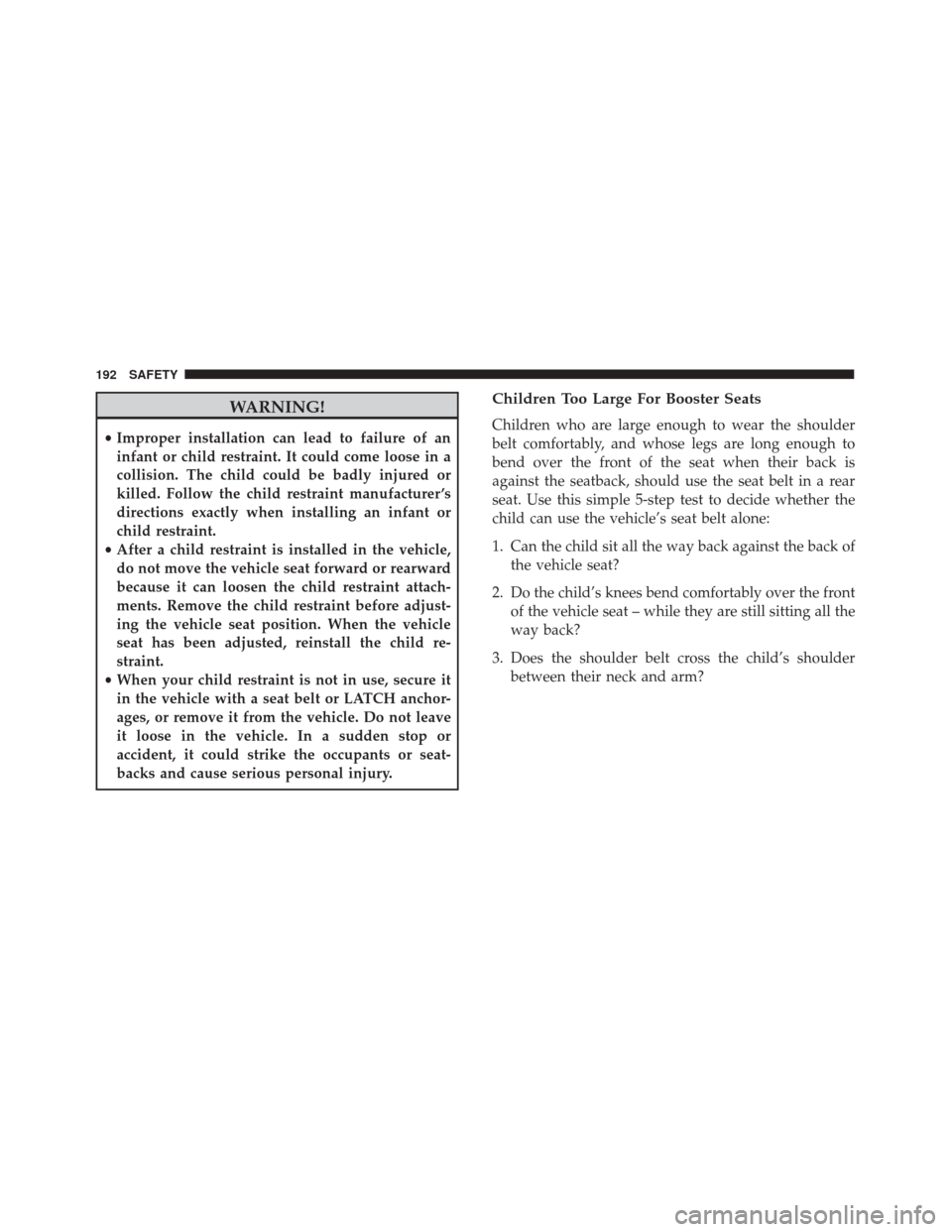
WARNING!
•Improper installation can lead to failure of an
infant or child restraint. It could come loose in a
collision. The child could be badly injured or
killed. Follow the child restraint manufacturer ’s
directions exactly when installing an infant or
child restraint.
• After a child restraint is installed in the vehicle,
do not move the vehicle seat forward or rearward
because it can loosen the child restraint attach-
ments. Remove the child restraint before adjust-
ing the vehicle seat position. When the vehicle
seat has been adjusted, reinstall the child re-
straint.
• When your child restraint is not in use, secure it
in the vehicle with a seat belt or LATCH anchor-
ages, or remove it from the vehicle. Do not leave
it loose in the vehicle. In a sudden stop or
accident, it could strike the occupants or seat-
backs and cause serious personal injury.
Children Too Large For Booster Seats
Children who are large enough to wear the shoulder
belt comfortably, and whose legs are long enough to
bend over the front of the seat when their back is
against the seatback, should use the seat belt in a rear
seat. Use this simple 5-step test to decide whether the
child can use the vehicle’s seat belt alone:
1. Can the child sit all the way back against the back of the vehicle seat?
2. Do the child’s knees bend comfortably over the front of the vehicle seat – while they are still sitting all the
way back?
3. Does the shoulder belt cross the child’s shoulder between their neck and arm?
192 SAFETY
Page 195 of 476
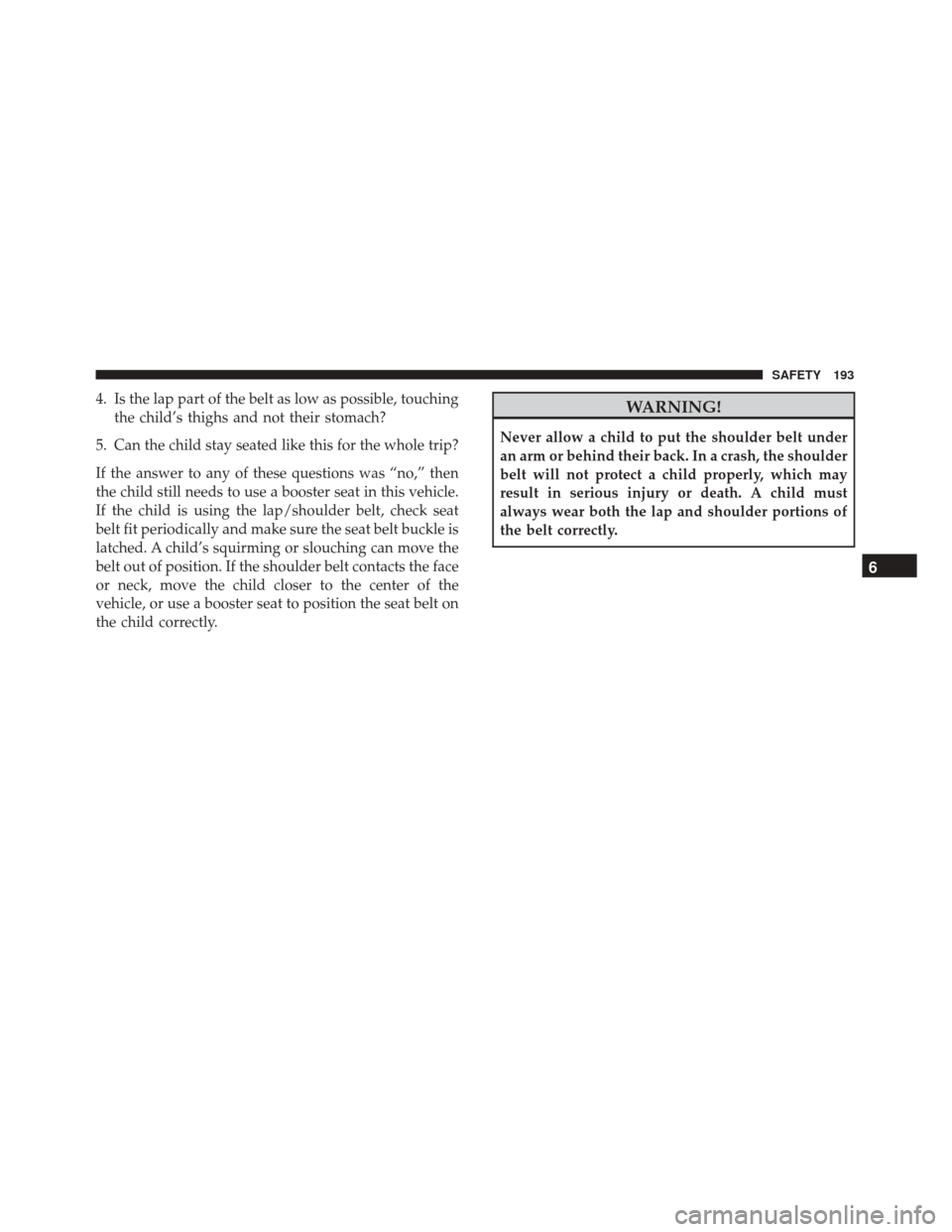
4. Is the lap part of the belt as low as possible, touchingthe child’s thighs and not their stomach?
5. Can the child stay seated like this for the whole trip?
If the answer to any of these questions was “no,” then
the child still needs to use a booster seat in this vehicle.
If the child is using the lap/shoulder belt, check seat
belt fit periodically and make sure the seat belt buckle is
latched. A child’s squirming or slouching can move the
belt out of position. If the shoulder belt contacts the face
or neck, move the child closer to the center of the
vehicle, or use a booster seat to position the seat belt on
the child correctly.WARNING!
Never allow a child to put the shoulder belt under
an arm or behind their back. In a crash, the shoulder
belt will not protect a child properly, which may
result in serious injury or death. A child must
always wear both the lap and shoulder portions of
the belt correctly.
6
SAFETY 193
Page 196 of 476
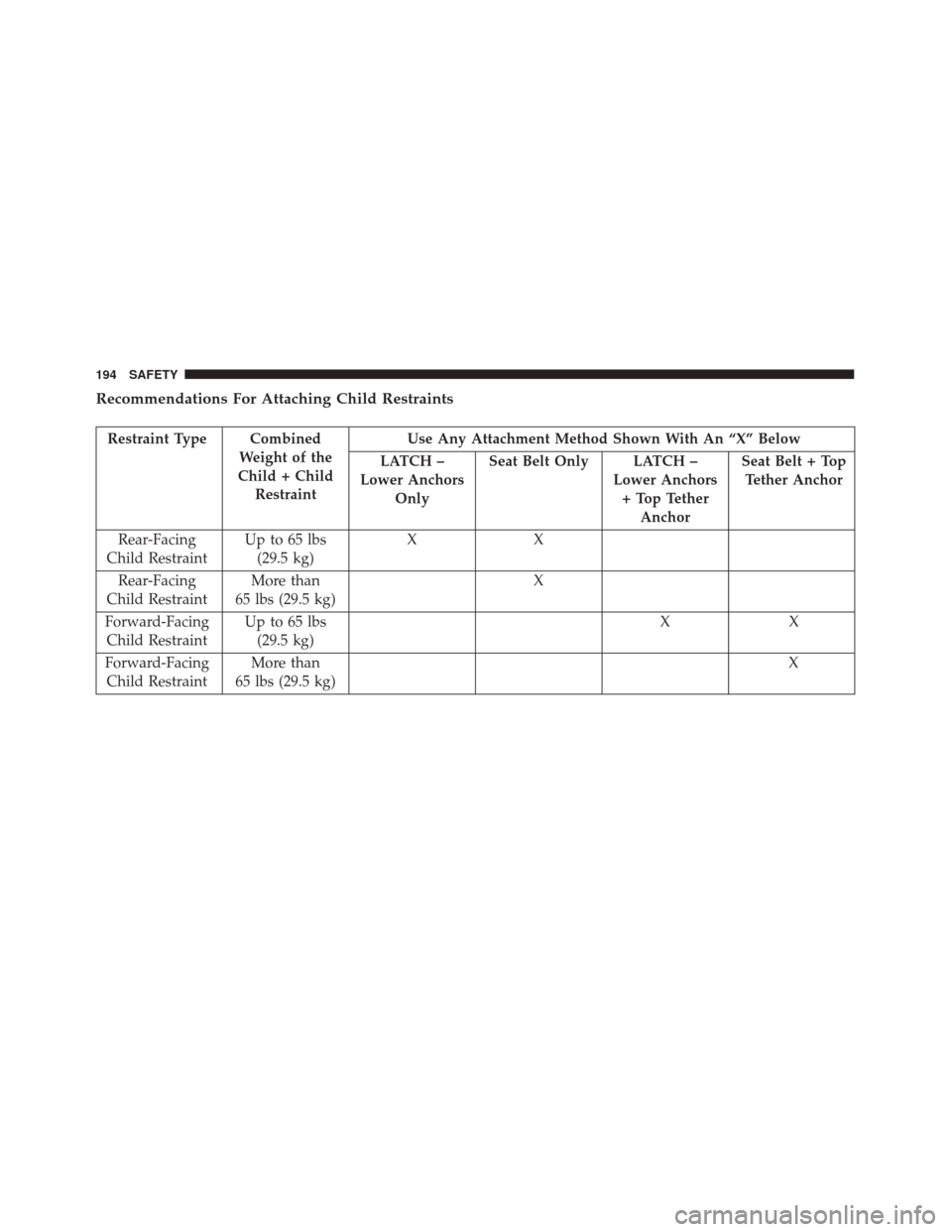
Recommendations For Attaching Child Restraints
Restraint Type CombinedWeight of the
Child + Child Restraint Use Any Attachment Method Shown With An “X” Below
LATCH –
Lower Anchors Only Seat Belt Only LATCH –
Lower Anchors+ Top Tether Anchor Seat Belt + Top
Tether Anchor
Rear-Facing
Child Restraint Up to 65 lbs
(29.5 kg) XX
Rear-Facing
Child Restraint More than
65 lbs (29.5 kg) X
Forward-Facing Child Restraint Up to 65 lbs
(29.5 kg) XX
Forward-Facing Child Restraint More than
65 lbs (29.5 kg) X
194 SAFETY
Page 197 of 476
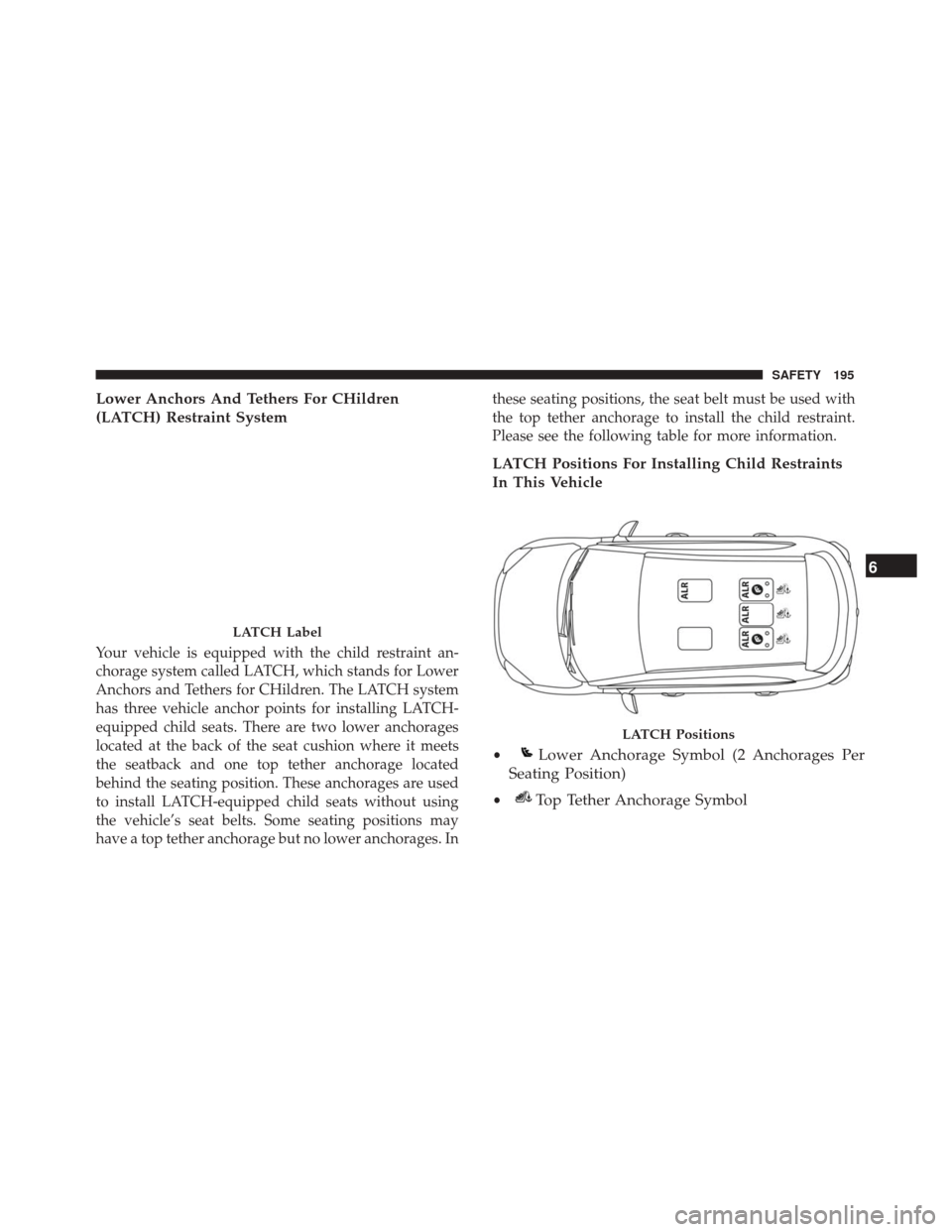
Lower Anchors And Tethers For CHildren
(LATCH) Restraint System
Your vehicle is equipped with the child restraint an-
chorage system called LATCH, which stands for Lower
Anchors and Tethers for CHildren. The LATCH system
has three vehicle anchor points for installing LATCH-
equipped child seats. There are two lower anchorages
located at the back of the seat cushion where it meets
the seatback and one top tether anchorage located
behind the seating position. These anchorages are used
to install LATCH-equipped child seats without using
the vehicle’s seat belts. Some seating positions may
have a top tether anchorage but no lower anchorages. Inthese seating positions, the seat belt must be used with
the top tether anchorage to install the child restraint.
Please see the following table for more information.
LATCH Positions For Installing Child Restraints
In This Vehicle
LATCH Label
LATCH Positions
•Lower Anchorage Symbol (2 Anchorages Per
Seating Position)
•Top Tether Anchorage Symbol 6
SAFETY 195
Page 198 of 476
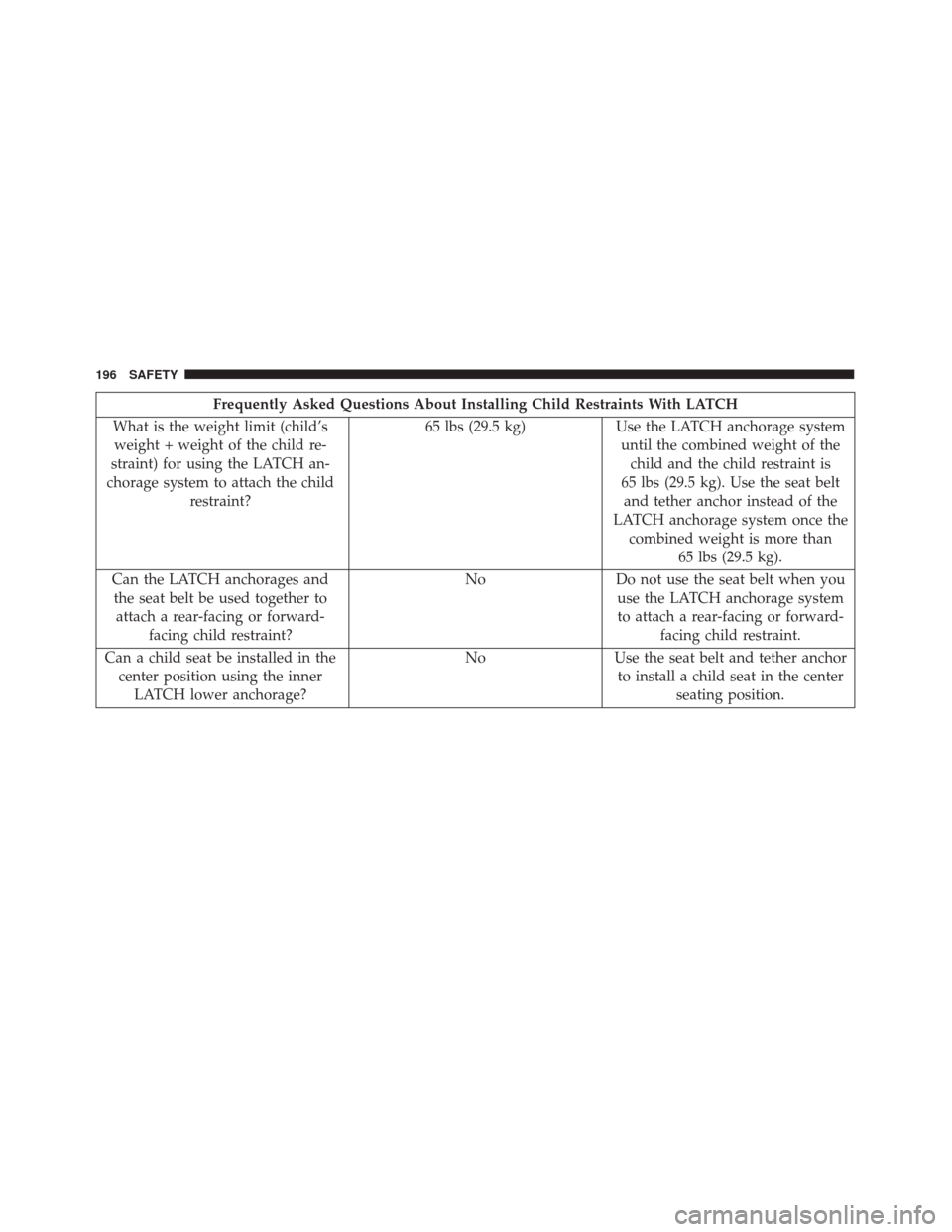
Frequently Asked Questions About Installing Child Restraints With LATCH
What is the weight limit (child’s weight + weight of the child re-
straint) for using the LATCH an-
chorage system to attach the child restraint? 65 lbs (29.5 kg) Use the LATCH anchorage system
until the combined weight of thechild and the child restraint is
65 lbs (29.5 kg). Use the seat belt and tether anchor instead of the
LATCH anchorage system once the combined weight is more than 65 lbs (29.5 kg).
Can the LATCH anchorages and the seat belt be used together to attach a rear-facing or forward- facing child restraint? No Do not use the seat belt when you
use the LATCH anchorage systemto attach a rear-facing or forward- facing child restraint.
Can a child seat be installed in the center position using the inner LATCH lower anchorage? No
Use the seat belt and tether anchor
to install a child seat in the center seating position.
196 SAFETY
Page 199 of 476
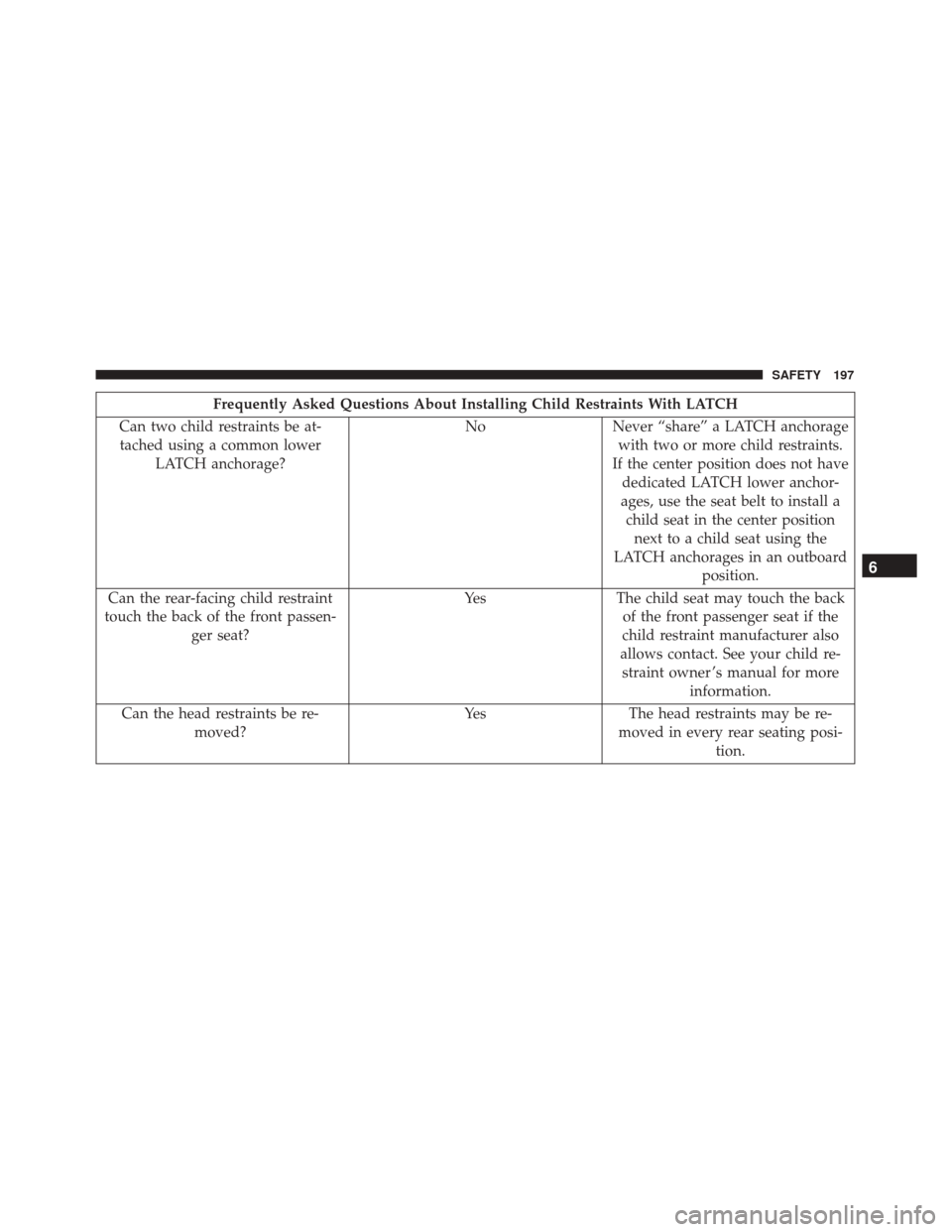
Frequently Asked Questions About Installing Child Restraints With LATCH
Can two child restraints be at- tached using a common lower LATCH anchorage? No
Never “share” a LATCH anchorage
with two or more child restraints.
If the center position does not have dedicated LATCH lower anchor-
ages, use the seat belt to install a child seat in the center position next to a child seat using the
LATCH anchorages in an outboard position.
Can the rear-facing child restraint
touch the back of the front passen- ger seat? Yes
The child seat may touch the back
of the front passenger seat if the
child restraint manufacturer also
allows contact. See your child re- straint owner ’s manual for more information.
Can the head restraints be re- moved? Yes
The head restraints may be re-
moved in every rear seating posi- tion.
6
SAFETY 197
Page 200 of 476
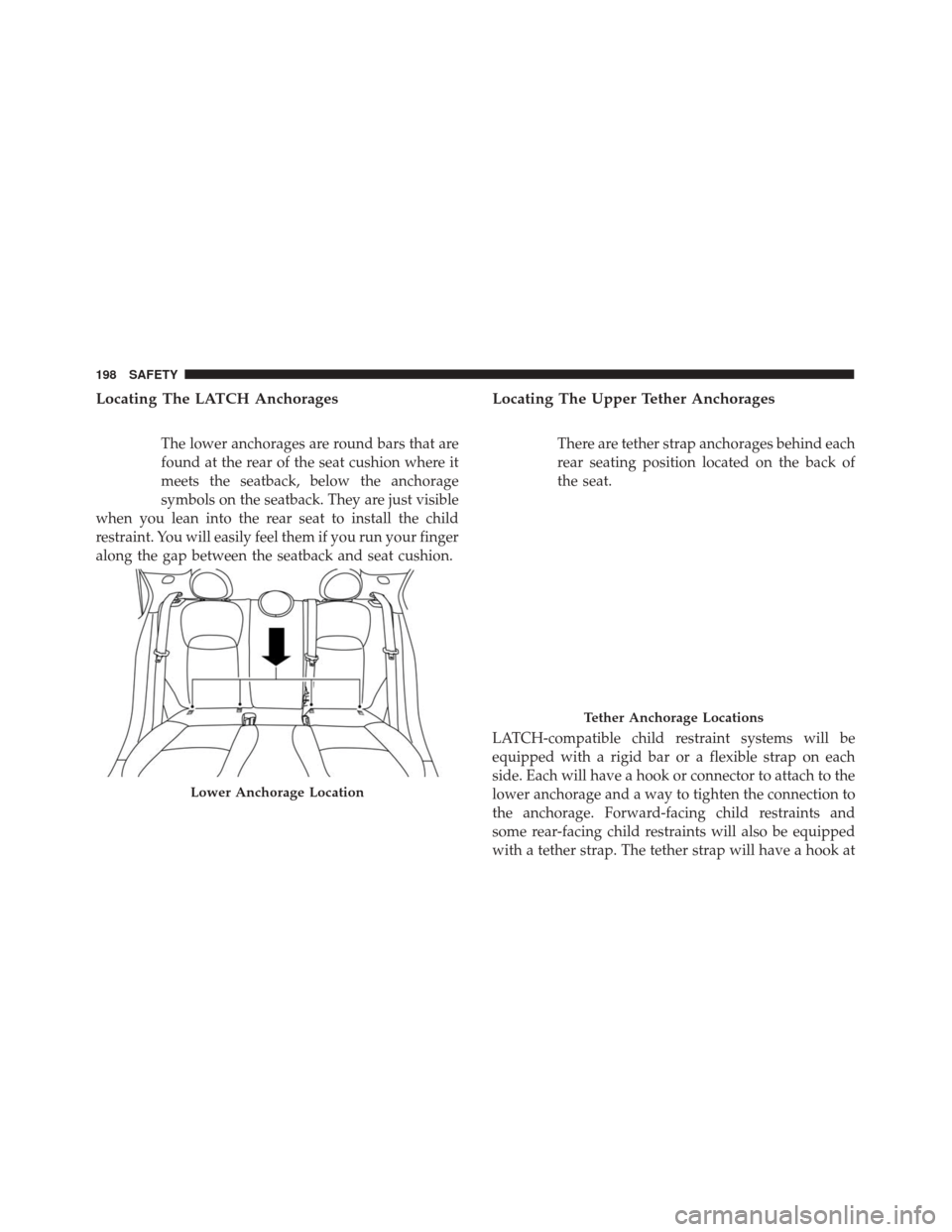
Locating The LATCH Anchorages
The lower anchorages are round bars that are
found at the rear of the seat cushion where it
meets the seatback, below the anchorage
symbols on the seatback. They are just visible
when you lean into the rear seat to install the child
restraint. You will easily feel them if you run your finger
along the gap between the seatback and seat cushion.
Locating The Upper Tether Anchorages
There are tether strap anchorages behind each
rear seating position located on the back of
the seat.
LATCH-compatible child restraint systems will be
equipped with a rigid bar or a flexible strap on each
side. Each will have a hook or connector to attach to the
lower anchorage and a way to tighten the connection to
the anchorage. Forward-facing child restraints and
some rear-facing child restraints will also be equipped
with a tether strap. The tether strap will have a hook at
Lower Anchorage Location
Tether Anchorage Locations
198 SAFETY